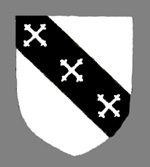The Manor of Hulcote
The histories of manors in Bedfordshire are given in Volume III of The Victoria County History for Bedfordshire published in 1912. Holcot Manor was in the hands of William Speke at the time of the Domesday survey of 1086. The overlordship later passed to the Barony of Eaton [Eaton Socon] which was in the hands of the Beauchamp family. It is last referred to in 1428 whilst still part of the Barony.
Ralph Passwater was tenant of the manor in 1086 and in the 13th century his descendant Gilbert was Lord of the Manor, owing service to the overlord, the Barony of Eaton. The last member of the family to hold the manor was William, who conveyed it to Nicholas Fermbaud in 1337. In 1366 Katherine Fermbaud and her husband John Woodville held the manor as did Thomas Fermbaud alias Woodville in 1428. Sir Richard Woodville was Lord in 1449.
Richard Woodville's descendant was Margaret Helwell who married Thomas Sherard, they had two sons, Richard and George and in 1541 George Sherard alienated the manor to his brother Richard who sold it later that year to Robert Chernock.

The Chernock family coat of arms
The Chernock family remained Lords of the Manor of Holcot until the death of Sir Villiers Chernock in 1779. The manor then passed to his nephew Edward Hervey, son of his sister Helen. Hervey left no male heirs and his estates were devised to Elizabeth Chauncey, his only surviving sister. She divided them between her great-nieces. Part of the manor devolved to William Montague and George Henry Montague held half the manor in 1826. His heir was a man named Bennett who held half of the manor into the 20th century. The other half of the manor devolved to Charlotte Orlebar Smith, this was, in turn divided between her great-grandson Charles Villiers Downes, who was killed in the First World War and Boteler Chernock Smith, Charlotte's grandson.
A succession of Law of Property Acts in the 1920s extinguished all manorial incidents, courts and copyhold tenure of land. This effectively abolished manors in all but name.
The Bedfordshire Historic Environment Record [HER] contains information on the county's historic buildings and landscapes and summaries of each entry can now be found online as part of the Heritage Gateway website. Earthworks indicating the site of the medieval Manor House and its garden appear on aerial photographs taken in 1946 [HER 28]. The earthworks lie north-east of the church. A medieval fishpond complex [HER 3423], constructed for the manor house has also been identified. The house was rebuilt in 1575, and the ponds were probably modified and incorporated in garden landscaping then or later. The main pond, to the south of the complex, is retained by an earthwork about ten feet high, and the ponds to the north by other substantial earthworks. The site was included in A. W. Guppy's list of moated sites, but is not now thought to include a moat.
The house survived at least as late as 1812. Thomas Orlebar Marsh was working on the engraving shown below in that year and mentions in a letter [CRT180/537] that the property, then called Hulcote House, was by then much dilapidated. Today occupies a small part of the site of the manor and its grounds.
![Hulcote House [LL18-29]](/CommunityHistories/Hulcote/HulcoteImages/Hulcote House [LL18-29]_350x232.jpg) Hulcote House [LL18/29]
Hulcote House [LL18/29]